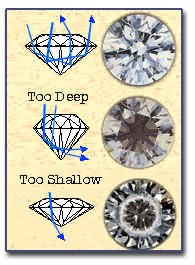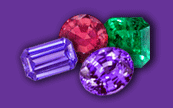The cut of a diamond is related to its proportion. Many cutters choose to sacrifice some of the diamond's beauty to achieve a stone that is a larger carat weight. Cut, more than any other quality aspect, gives the diamond its sparkle. A diamond gets its brilliance and scintillation by cutting and polishing the diamond facets to allow the maximum amount of light that enters through its top to be reflected and dispersed back, also through its top. With proper cutting (diagram 1) the light passes through the top, bounces off the sides, and then travels back out the top, giving the diamond optimum brilliance. If the diamond is cut too shallow (diagram 2), light passes through the bottom of the diamond. If the diamond is cut too deep (diagram 3), light passes through the side of the diamond, in both cases inhibiting maximum brilliance.

Two popular overall proportion indicators are Total Depth Percentage (D%) and Table Percentage (T%). D% is the diamond's depth expressed as a percentage of its width (average diameter for rounds). T% is the diamond's "table" width expressed as a percentage of its overall width (diameters for rounds). Round diamonds with cutting proportions within the range generally considered attractive have depths from 55 to 63 percent. The table size of most round diamonds lies between 56 and 64 percent . With non-round shapes ("fancy" shapes), much greater proportion variations are encountered. In most fancy shapes, higher D% and T% are more common and are dependent on width to length ratios.








